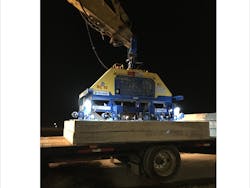Versatility is key for highway contractors in charge of navigating an array of worksite variables that revolve around lane closures, time restrictions, the staging of materials and use of construction equipment.
Duit Construction Company applied its multifaceted approach to safely increasing momentum during a recent pavement rehabilitation project that included a decaying mile-long stretch of Interstate 40 in Oklahoma City, running east to Interstate 44 from Meridian Avenue.
For Duit, the best outcome hinged on good timing to keep workers and motorists safe, the flow of traffic moving and construction delays to a minimum while resurfacing 22,000 sq ft of six-lane roadway. “It was a bad stretch of road,” said Jacy Messer, concrete superintendent with Duit, noting that about half, or 11,000 sq ft, of the aggregate was repaired – and the rest replaced – over the course of a six-month campaign segmented into weekly milestones.
Originally, the Oklahoma Department of Transportation (ODOT) had planned on Duit pulling slabs and pouring back in the same night. However, Duit’s plan, Messer said, called for the manufacture of approximately 200 precast concrete panels, which were used by the contractor to create new sections of temporary roadway on weeknights as dilapidated materials were removed.
The strategy called for a technology driven solution that could expedite the process of lifting badly worn concrete slabs without causing damage to the subgrade. Duit’s answer was to employ two Vacuworx Octapads, operating in conjunction with Vacuworx RC 10 vacuum lifters and CAT 336 excavators, to extract the 15-ft long by 12-ft-wide slabs which were cut into four 2,500 lb pieces.
The Octapad, with a lifting capacity of 11,888 lb, includes eight flat pads with individual vacuum values that can be shut off when directly over a crack, pothole or area of the slab that is too damaged for lifting. The system is designed to completely remove slab from the roadbed, leaving the sub-base undisturbed for the subsequent patch pour.
Turnaround times on repeatedly handling and re-handling the 7.5-ft-long by 12-ft-wide precast panels, which were installed and backfilled by Duit using an asphalt cold patch to close gaps and keep height tolerance levels within a half inch, were also decreased exponentially, Messer said. That was attributed to wireless remote operation and the ability to rotate materials 360°, giving the operator an edge on safety and efficiency while loading, unloading and staging materials from the excavator’s cab.
“Under our time restriction, we could only effect lane closures on the weekdays between 7 p.m. to 6 a.m.,” Messer said. “We used the Vacuworx lifter to put in our precast panels four nights a week, and then to yank them out before pouring an entire section on Friday morning. On Mondays, we were at full strength and ready to start again.”
The primary benefits associated with decreasing construction project times include a reduction in traffic delays and fewer collisions associated with construction-related accidents. Messer, comparing the contractor’s experience with the Octapad to conventional “pin and feather” technique, said that the vacuum lifter reduced the time to pull slabs by a third because no drills, jackhammers or slab buckets were required.
“The road was extremely deteriorated with cracks everywhere,” he said. “A lot of times there would be a crack inside one of the pieces. With a trackhoe bucket scooping out the concrete, you risk disturbing the subgrade. For us, there was no subgrade work at all. All we would have to do is shut down two or four of the eight pads and pull out a chunk at a time.”
The right timing also allowed Duit to put a dent in its hard costs by using aggregate with a standard 36-hour cure time for permanent pours, as opposed to fast-track concrete mix that is about three times more expensive. A customized quick coupling bucket system and fast-attach hoses helped hasten set up and tear down times on the lifting equipment, turning what Messer said used to take an hour into a five-minute job.
“We were doing about 150 cubic yards of concrete every day, or 500 to 600 per week,” he said. “Without the vacuum lifter, you’d be lucky to remove 50 cubic yards per night.
Editor's Note: Scranton Gillette Communications and the SGC Infrastructure Group are not liable for the accuracy, efficacy and validity of the claims made in this piece. The views expressed in this content do not reflect the position of the Roads & Bridges' Editorial Team.
